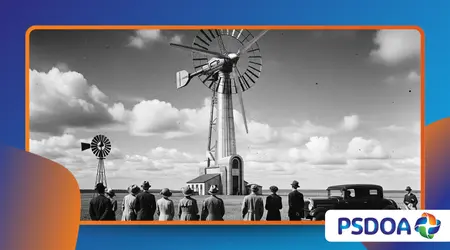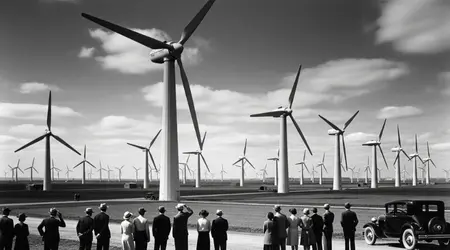When Wind Power Was the Future — In 1930

When Wind Power Was the Future In 1930, the potential of harnessing atmospheric currents captivated some of the brightest engineers and entrepreneurs.
Anúncios
Today, as we rapidly build massive wind farms globally, few remember that the seeds of this renewable energy revolution were sown nearly a century ago, not in response to climate change, but to simple economic necessity and the desire for rural independence.
This early era of innovation, largely overshadowed by the rise of cheap fossil fuels, provides critical lessons about technological foresight and market disruption.
It seems almost paradoxical that the very concepts driving our current green transition were meticulously studied and prototyped during the Great Depression.
The 1930s were, in fact, a crucial incubation period for decentralized power. Rural America, largely ignored by the large utility companies due to the high cost of running power lines, eagerly embraced small-scale wind generators.
Anúncios
This necessity fostered a culture of electrical self-sufficiency, giving rise to names like the Jacobs Wind Electric Company, whose generators became icons of independent power.
The early commitment to wind was not merely a niche solution; it was a deeply competitive technological pursuit.
Engineers pushed the boundaries of material science and aerodynamics to develop turbines far exceeding the scale of anything previous.
They sought to integrate wind into the nascent national power grid, believing firmly in its long-term economic viability.
This forgotten chapter in energy history proves that great ideas are often cyclical, simply awaiting the right economic or political conditions to truly flourish.
Why Did Wind Energy Thrive in Rural 1930s America?
The decade of the 1930s presented a stark contrast between electrified urban centers and vast, dark rural areas.
Only about 10% of U.S. farms had access to grid electricity early in the decade. The major utilities viewed rural electrification as unprofitable, demanding massive fees to run lines across sparsely populated territories.
What Economic Niche Did Small Wind Generators Fill?
Small wind chargers offered the only viable path to modern conveniences like electric lights, radio, and refrigeration for countless farm families.
These machines, often rated from one to three kilowatts, charged banks of lead-acid batteries, providing essential DC power.
The initial investment, while substantial for a farm family, was often cheaper and quicker than waiting for a distant power company to extend their network.
Companies like Wincharger and, most famously, Jacobs, transformed the lives of hundreds of thousands.
They sold the dream of independence, where the relentless prairie winds offered a free, continuous fuel source, circumventing the need for expensive coal or gasoline generators.
++ The 8-Track Tape: Why It Rose Fast and Fell Faster
The simplicity and robustness of these early designs allowed farmers to maintain and repair their own power sources, fostering a true sense of energy autonomy.
This market success, driven by neglect rather than governmental policy, laid the foundation for technical advancement.
The robust, multi-bladed turbines from this era proved incredibly durable, a testament to practical, resourceful engineering under economic duress.

How Did Early Engineers Plan to Integrate Wind into the National Grid?
The true ambition of the wind power pioneers extended far beyond lighting farmhouses. They envisioned utility-scale wind farms working in tandem with existing central power stations, a concept we are only now fully realizing.
This foresight demonstrates an intelligent approach to the intermittent nature of wind energy.
Also read: How Vacuum Trains Were Almost a Reality in the 1800s
What Was the Significance of the Smith-Putnam Turbine?
The most striking example of this early ambition was the Smith-Putnam wind turbine, erected in Vermont in the early 1940s, though its development was rooted firmly in 1930s conceptual design and planning.
Conceived by Palmer Cosslett Putnam and manufactured by the S. Morgan Smith Company, this machine was a colossal engineering feat for its time. It was the world’s first megawatt-sized turbine, rated at 1.25 MW.
This colossal machine was intended to synchronize with the local alternating current utility grid, operating alongside a hydroelectric plant to stabilize output.
The engineers understood that hydro’s controllable output could compensate for wind’s variability, a core grid strategy utilized globally today.
The sheer scale and complexity of the two-bladed, 175-foot diameter rotor machine made with stainless steel blades marked an unparalleled investment in wind technology, showing a deep commercial belief in its future.
Read more: Roman Concrete: How Ancient Builders Created Structures That Lasted Millennia
The Smith-Putnam turbine operated successfully, feeding power to the Central Vermont Public Service Corporation’s grid for hundreds of hours starting in 1941.
Sadly, a known design flaw in one of the blade spars, exacerbated by wartime material shortages preventing reinforcement, led to a catastrophic blade failure in 1945.
Though the technology was sound, the project was dismantled due to high repair costs and the sudden shift in the energy landscape.
Why Did the Wind Dream Collapse After World War II?
Despite these promising early successes, the post-war energy economy delivered a powerful, almost fatal blow to the burgeoning wind industry.
The economic forces aligned against wind power were overwhelming, leading to the collective amnesia about When Wind Power Was the Future In 1930.
H3: What Killed the Economic Viability of Early Wind Projects?
Two major, interconnected factors halted wind’s progress. First, the 1936 Rural Electrification Act (REA) dramatically changed the economic reality for rural communities.
With massive federal loans, local cooperatives built out the grid, making cheap, centralized coal and hydro power available to farms. This effectively eliminated the niche market for small, decentralized wind generators.
Second, the post-war era brought an unprecedented age of cheap fossil fuels, primarily oil and natural gas.
The costs associated with generating a stable kilowatt-hour from wind simply could not compete with the low marginal cost of burning inexpensive, abundant fossil fuels.
Why would an electric company invest in an intermittent source when coal offered higher capacity factors and more predictable output? This economic reality relegated wind power to a curiosity for decades.
Wind energy in the 1930s was like the first steam-powered car technically feasible and revolutionary, but it appeared just before the mass-produced, cheaper, and more reliable gasoline engine (fossil fuels) took over the entire road network. It was a victim of perfect economic timing for its competitor.
What Statistical Evidence Shows the Energy Shift of the Era?
The shift from decentralized wind to centralized fossil fuels is clearly visible in the energy data of the time. The increasing capacity of thermal power plants far outpaced the limited utility-scale wind projects.
Comparing the Reliability of Early Wind vs. Coal Power
The central issue facing early wind was the capacity factor the ratio of actual output to maximum possible output a challenge that persists today.
While modern wind technology improves this greatly, the early utility-scale models struggled to match coal’s constant generation profile.
The following table provides a conceptualized comparison of the general energy picture for power generation sources prevalent during the 1930s and 1940s:
| Power Source (circa 1945) | Typical Size/Capacity | Estimated Capacity Factor (Approx.) | Key Advantage |
| Coal-Fired Plant | 10 MW to 100 MW+ | 60% – 70% | High Predictability & Scale |
| Smith-Putnam Turbine | 1.25 MW | Est. 20% – 30%* | Zero Fuel Cost |
| Farm Wind Charger | 1 kW to 3 kW | Varies Highly (Decentralized) | Rural Independence |
*While the Smith-Putnam project demonstrated a 1.25 MW capacity, its economic capacity factor over a year could not compete with continuous coal power, even before the catastrophic failure.
The Dominance of Thermal Energy
The relentless expansion of thermal power became the defining energy statistic of the era. The sheer volume of energy produced by burning coal and oil quickly made all other sources seem insignificant.
This high-volume, cost-effective centralized generation ultimately won the market battle, postponing the wind power revolution by fifty years.
In the mid-1930s, prior to the REA’s full impact, a notable 90% of rural U.S. households lacked electricity, creating the vast market that wind pioneers initially exploited before being replaced by the grid’s arrival.
Why Is This History Important for Today’s Energy Decisions?
The narrative of When Wind Power Was the Future In 1930 is not merely a historical footnote; it offers a profound cautionary tale.
It shows how non-technological factors politics, cheap resources, and infrastructure development can derail a promising innovation.
What Lessons Can Modern Investors Learn from the 1930s Collapse?
Today’s investors and policymakers must recognize that technological viability does not guarantee market success.
The early wind failure teaches us that large-scale infrastructure and supportive energy policies (like the REA for coal) are necessary to make clean energy ubiquitous.
Furthermore, it highlights the enduring challenge of intermittency, which remains the modern wind industry’s primary engineering focus.
The initial, expensive failure of the Smith-Putnam turbine was not a waste, but a massive R&D project whose public domain findings informed subsequent attempts decades later.
Palmer Putnam’s work saved future engineers years of trial-and-error, proving the power of documented failure.
Think of it: if the material shortage of World War II had not prevented the blade reinforcement, could the history of American power generation have been fundamentally different?
This question should make us pause. Are we allowing current, non-engineering bottlenecks to slow down essential progress today?
Conclusion: The Persistence of a Good Idea
The story of When Wind Power Was the Future In 1930 is a compelling reminder that the path of progress is rarely linear.
A brilliant, sustainable, and essential idea was simply ahead of its time, temporarily eclipsed by the irresistible economic force of cheap fossil fuels and government-backed infrastructure.
The dream of clean, decentralized power never truly died; it merely went dormant, awaiting better materials, advanced computing, and the compelling necessity of the climate crisis to reawaken it.
Today’s towering turbines are the true descendants of those humble Jacobs generators and the colossal, ill-fated Smith-Putnam project. They stand as a testament to the persistence of an idea whose time has finally, irrevocably arrived.
What forgotten invention do you believe deserves a second chance in our modern world? Share your experience or knowledge in the comments below and join the discussion.
Frequently Asked Questions (FAQ)
Did the early wind generators of the 1930s directly influence modern turbine design?
While modern, high-speed, three-bladed turbines are very different, the early work of pioneers like the Jacobs brothers and, crucially, the public research documentation from the Smith-Putnam project, laid foundational knowledge regarding aerodynamics, materials stress, and grid synchronization which directly benefited later engineers.
What was the main technical problem that led to the Smith-Putnam failure?
The primary technical cause was metal fatigue at a critical point of stress on one of the 8-ton stainless steel blades.
This weakness was known, but wartime restrictions on steel and labor prevented the necessary repairs and reinforcements before the final catastrophic break occurred in 1945.
How did the Rural Electrification Act (REA) affect wind power?
The REA, passed in 1936, delivered low-cost, reliable, centralized power to rural areas.
This move eliminated the primary market for small, self-sufficient wind chargers, which could not compete economically with the newly available, subsidized grid power. It was a policy decision that unintentionally delayed wind’s mass adoption.
Why were the early wind generators only DC (Direct Current)?
Small farm generators produced DC power because their primary function was to charge battery banks. Batteries store DC power, which was then used to run DC appliances like lights and small motors.
AC power, necessary for running a modern utility grid, requires more complex inverters and regulation systems, making DC simpler and more practical for off-grid homes.
